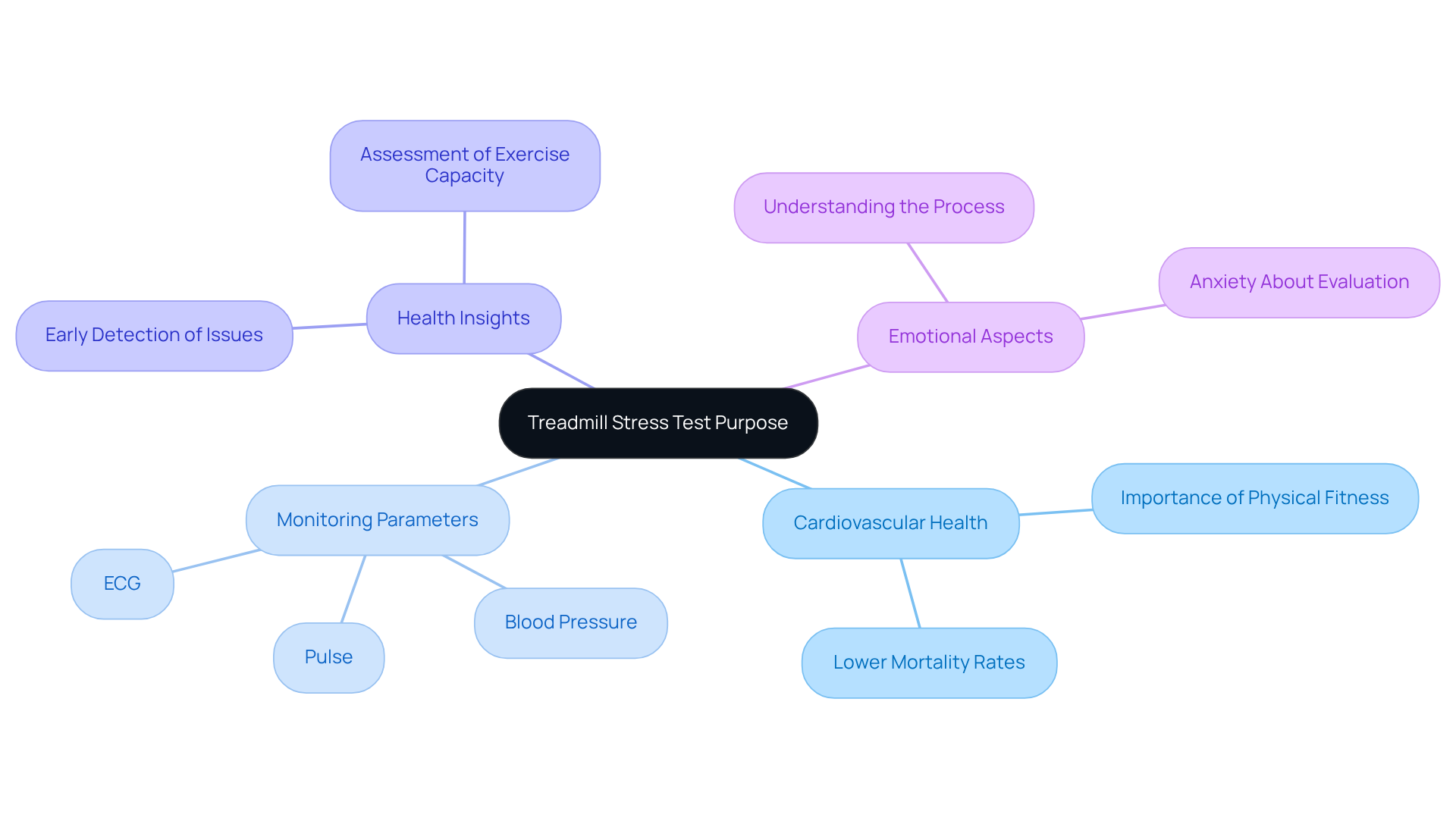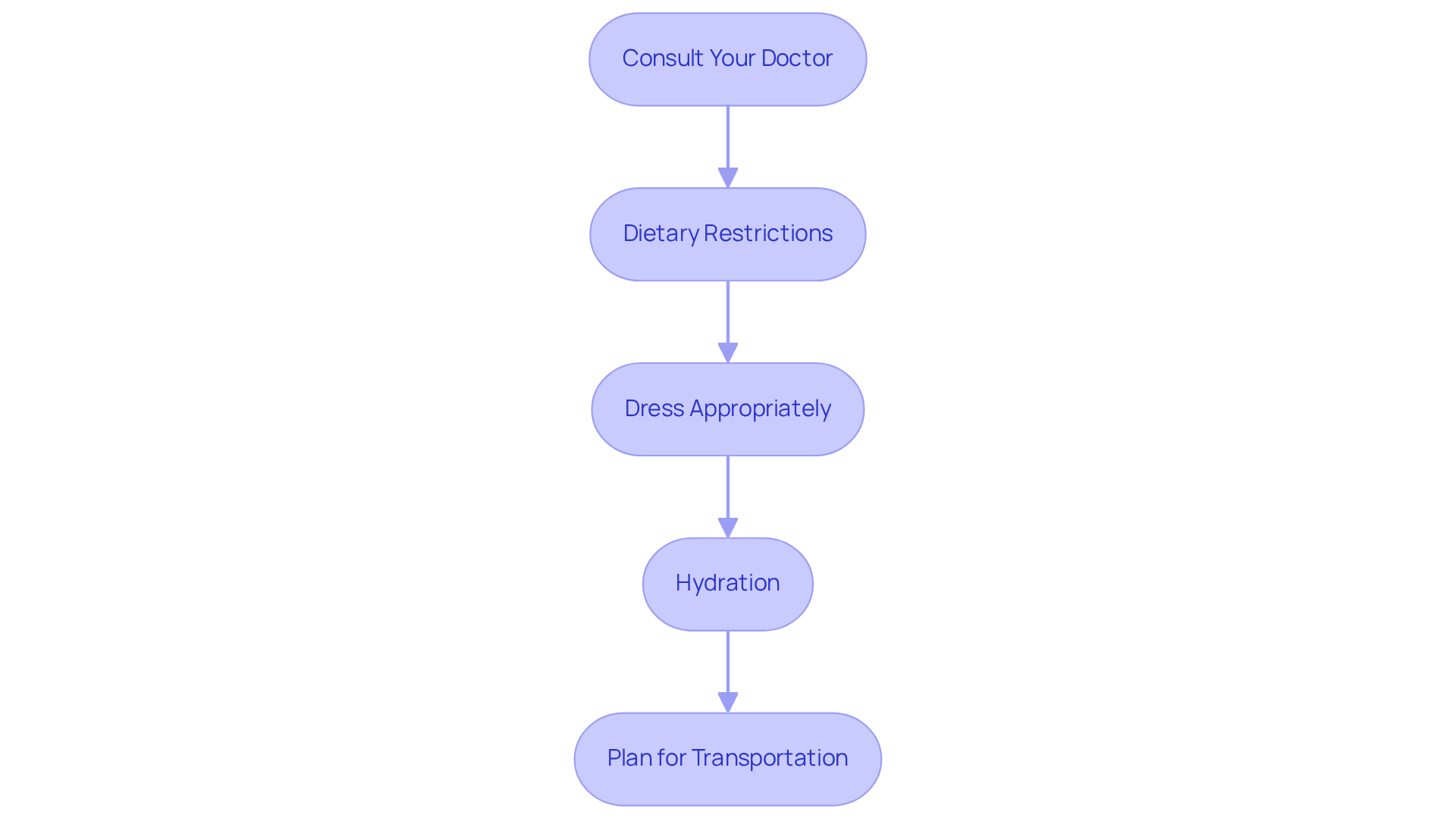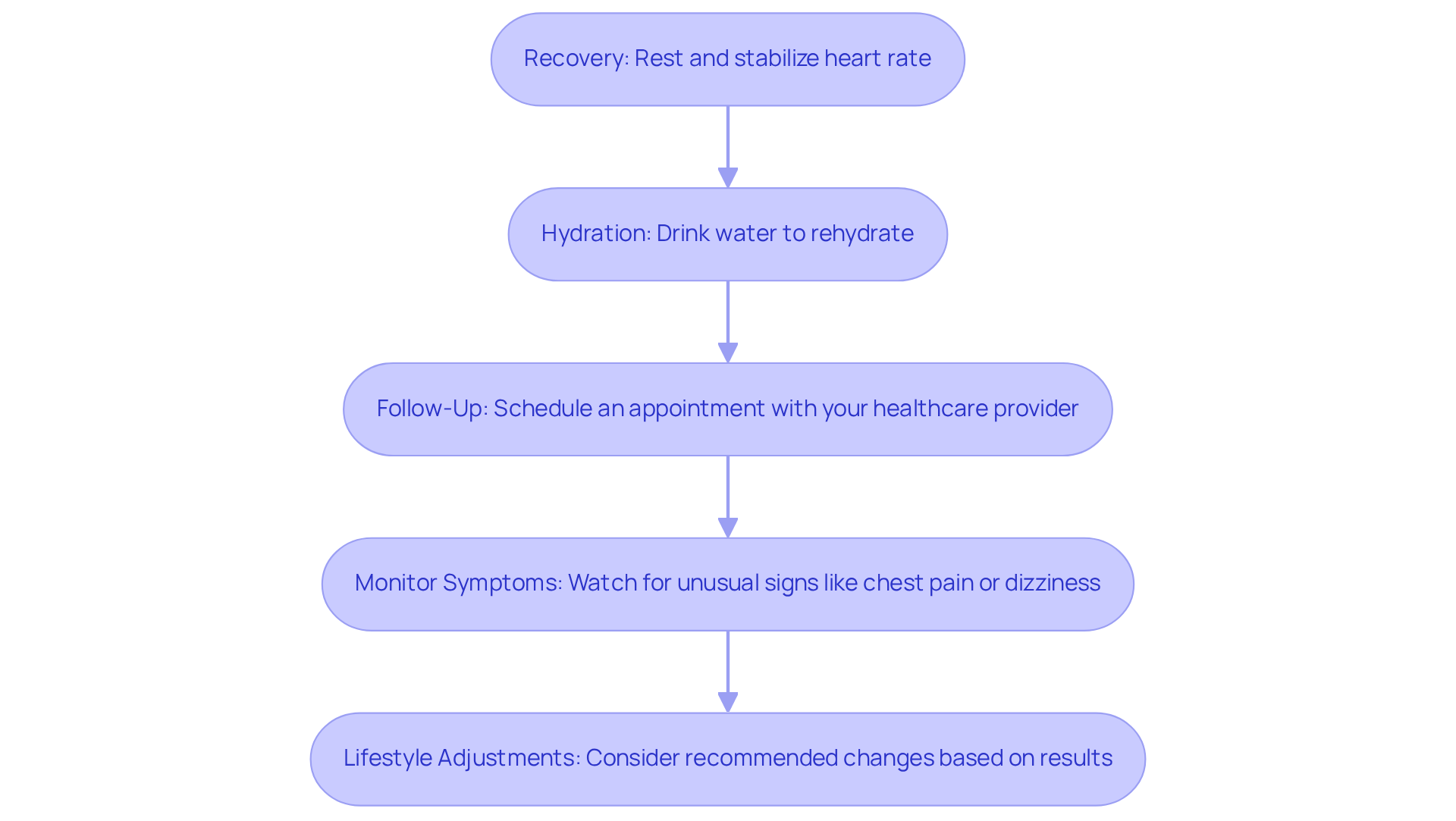


Navigating a treadmill stress test can feel daunting, especially for those concerned about their cardiovascular health. This evaluation is vital; it not only shows how your heart handles physical exertion but also acts as a safeguard against serious conditions like coronary artery disease. With the right preparation and understanding, you can approach this test with confidence and peace of mind.
Have you ever wondered what steps you can take to ease your anxiety during this process? Knowing what to expect can make a world of difference. By familiarizing yourself with the test and its purpose, you can transform apprehension into empowerment. Remember, you’re not alone in this journey; many share your concerns and are seeking the same clarity.
In addition to this, consider reaching out to your healthcare provider for guidance. They can offer valuable insights and support tailored to your needs. Taking these proactive steps not only prepares you for the test but also reinforces your commitment to your health.
Ultimately, understanding the treadmill stress test is about more than just the procedure; it’s about taking charge of your health and well-being. Embrace this opportunity to learn and grow, knowing that support is always available.
A treadmill effort assessment, or exercise evaluation, is an important step in understanding how to pass a treadmill stress test to gauge your cardiovascular health during physical activity. Have you ever wondered how your heart responds to stress? This evaluation helps us see just that, allowing healthcare professionals to assess how well your cardiovascular system performs under pressure. It’s crucial for identifying potential issues like coronary artery disease (CAD) and arrhythmias.
During the examination, your pulse, blood pressure, and ECG (electrocardiogram) readings are closely monitored. This helps us understand your heart's function when it's working hard. Recent studies have shown that patients who can successfully complete treadmill exercises tend to have a significantly lower mortality rate, regardless of their risk factors for coronary artery disease. This highlights just how vital physical fitness is for maintaining cardiovascular health.
Cardiologists emphasize that these exercise evaluations are key in spotting cardiac issues early on. They provide valuable insights into how your heart manages exertion. In fact, real-world examples demonstrate that treadmill evaluations can effectively detect arrhythmias, allowing for timely interventions.
Understanding how to pass a treadmill stress test can help ease any anxiety you might feel about the evaluation process. It’s perfectly normal to have concerns, but knowing what to expect can make a big difference. Remember, this assessment is a step toward better cardiovascular health, and we’re here to support you every step of the way.

Preparing for how to pass a treadmill stress test can feel a bit daunting, but with the right steps, you can approach it with confidence. Here’s how to make the process smoother:
Consult Your Doctor: It’s crucial to discuss all medications you’re currently taking. Let your physician know about everything, as they may recommend adjusting or temporarily stopping certain medications, particularly beta-blockers, which can significantly influence your pulse rate during the test. Dr. Raul Alonso shares, "Using the latest in diagnostic and treatment options, we are able to provide our patients with superior, state of the art heart care in a comfortable environment."
Dietary Restrictions: To help ensure the best results, try to avoid heavy meals, caffeine, and alcohol for at least 24 hours before your test. Ideally, it’s best to refrain from eating or drinking anything for about three hours prior to the examination. Keeping your stomach empty is important for more accurate readings, especially when learning how to pass a treadmill stress test.
Dress Appropriately: Choose comfortable, loose-fitting clothing and supportive athletic shoes. It’s wise to leave behind any jewelry or accessories that could interfere with the assessment, allowing you to move freely and comfortably.
Hydration: Staying hydrated is important, but try not to drink large amounts of water right before the test. Small sips are perfectly fine to keep you hydrated without causing discomfort.
Plan for Transportation: It’s a good idea to arrange for someone to drive you home after the examination, especially if you think you might feel tired or lightheaded afterward. This ensures your safety and comfort as you recover from the procedure.
Remember, the entire treadmill evaluation process takes about an hour, so it’s helpful to plan your day accordingly. You’re taking an important step for your health, and we’re here to support you every step of the way, including guidance on how to pass a treadmill stress test.

When you arrive for your treadmill stress test at Amavita Heart and Vascular Health, here’s what you can expect:
Initial Setup: A caring healthcare professional will greet you and attach electrodes to your chest to monitor your heart's electrical activity. They’ll also check your resting pulse and blood pressure, making sure your unique cardiovascular needs are addressed right from the start.
Starting the Test: You’ll begin walking on the treadmill at a gentle pace. Gradually, the treadmill will increase in speed and incline, following a specific protocol, often the Bruce protocol, which consists of stages lasting about 3 minutes each. This method is designed to give a thorough evaluation of how to pass a treadmill stress test and how your body responds to stress.
Observation: Throughout the test, your pulse, blood pressure, and ECG will be closely monitored. If you feel any discomfort, like chest pain or shortness of breath, please let the technician know. For many seniors, reaching the target pulse of around 128 beats per minute may happen more quickly due to age-related changes. This careful monitoring reflects Amavita's commitment to providing focused cardiovascular care for those at higher risk.
Reaching a target heart rate, typically around 85% of your maximum predicted heart rate calculated using the formula 220 minus your age, is important when learning how to pass a treadmill stress test. For many older adults, the assessment usually lasts about 6-8 minutes, which aligns with average treadmill durations for this age group. This approach ensures that the evaluation is tailored to your individual health status.
Completion: Once you reach the target pulse frequency or if you experience any significant symptoms, the test will be stopped. You’ll then be observed for a short time as your pulse rate returns to normal, which typically takes around 15 minutes. This monitoring is crucial to ensure your cardiovascular system is responding well after exertion, reflecting Amavita's philosophy of comprehensive care that addresses common cardiac concerns with advanced, minimally invasive treatments.
Remember, you’re not alone in this process. Our team is here to support you every step of the way.

After completing your treadmill stress test, it’s important to follow these guidelines to ensure a smooth recovery and to help you understand your results:
Recovery: You might feel a bit fatigued or slightly short of breath after the test. It’s perfectly normal! Take a few minutes to rest while your heart rate stabilizes. Feel free to sit or lie down as needed to aid your recovery.
Hydration: Rehydration is crucial, especially if you’re feeling thirsty. Drinking water helps restore the fluids you may have lost during the examination. Remember, staying hydrated is key to feeling better.
Follow-Up: It’s essential to arrange a follow-up appointment with your healthcare provider to discuss your examination results. This meeting is important because your provider will explain the findings and what they mean for your cardiovascular health. They’ll guide you on any necessary next steps. Engaging in follow-up care can significantly improve your outcomes. Programs like Amavita's CardioElite™ enhance this process by providing advanced, real-time diagnostic data and 24/7 cardiology consultation, ensuring comprehensive cardiovascular management and reducing readmissions.
Monitor Symptoms: Be vigilant for any unusual symptoms, such as persistent chest pain, dizziness, or shortness of breath. If you experience any of these, please contact your healthcare provider immediately for further evaluation. Your health is our priority.
Lifestyle Adjustments: Based on your results, your doctor may recommend lifestyle changes, further testing, or treatment options to enhance your cardiovascular health. Understanding how to pass a treadmill stress test is essential; normal evaluation outcomes may not require further examinations, while irregularities could lead to additional diagnostic procedures. Cardiologists emphasize that accurately interpreting these results is key to managing your heart health effectively. As Dr. Smith, a cardiologist, wisely notes, "Accurate interpretation of stress evaluation results is essential for customizing the appropriate treatment plan for each patient."
Incorporating these steps will help you recover effectively and ensure that you understand the implications of your test results. You’ll also benefit from comprehensive care options like those offered through Amavita's CardioElite™ program. Remember, you’re not alone in this journey; we’re here to support you every step of the way.

Understanding how to pass a treadmill stress test is essential for anyone looking to evaluate their cardiovascular health effectively. This assessment not only gauges your heart's performance under physical stress but also serves as a preventive measure to identify potential health issues early on. Embracing this evaluation can lead to significant insights into your heart health and overall fitness.
To prepare for the test, it’s important to:
The test itself involves monitoring heart rates and symptoms throughout, which is crucial for your safety and well-being. After the test, recovery and follow-up care are vital for interpreting results and making informed health decisions, ensuring you feel supported every step of the way.
Approaching a treadmill stress test with knowledge and preparation can help ease any anxiety you might feel and enhance the overall experience. Taking proactive steps towards your cardiovascular health isn’t just beneficial—it’s vital. Engaging in this process can lead to better health outcomes and a deeper understanding of your heart health, reinforcing the importance of regular check-ups and maintaining an active lifestyle. Remember, you’re not alone in this journey; reaching out for support can make all the difference.
What is the purpose of a treadmill stress test?
A treadmill stress test, or exercise evaluation, is designed to assess cardiovascular health during physical activity by monitoring how the heart responds to stress.
How does a treadmill stress test help in identifying health issues?
The test helps identify potential issues like coronary artery disease (CAD) and arrhythmias by monitoring pulse, blood pressure, and ECG readings while the heart is under exertion.
What are the benefits of successfully completing a treadmill stress test?
Patients who can successfully complete treadmill exercises have a significantly lower mortality rate, highlighting the importance of physical fitness for cardiovascular health.
Why are treadmill evaluations important according to cardiologists?
Treadmill evaluations are key in spotting cardiac issues early, providing valuable insights into how the heart manages exertion and allowing for timely interventions for conditions like arrhythmias.
How can understanding the treadmill stress test process help reduce anxiety?
Knowing what to expect during the evaluation can ease concerns and anxiety, as it is a step toward better cardiovascular health, with support available throughout the process.